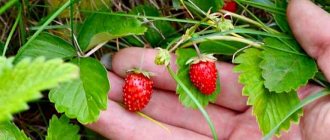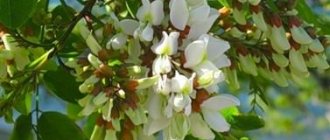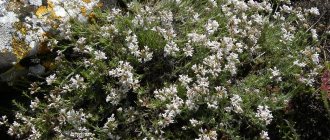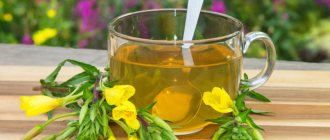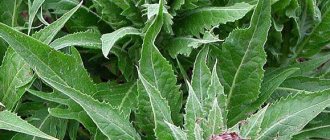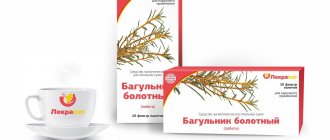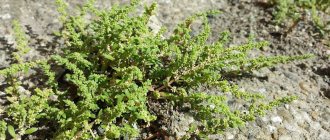|
Dear blog visitor!
I have prepared a gift for you - “Problem Solving Practices”, which will help you learn how to get answers to your questions and find the best way out of the current situation.
Pick up your gift using this link >>>
Wheatgrass is the second unique plant that should be on every table. Just like burdock and dandelion, the healing properties of wheatgrass are unique. Not using this plant to strengthen your body is an unacceptable mistake.
Attention! The material contains information that is recommended to be used under the supervision of a specialist.
Creeping wheatgrass - description
Creeping wheatgrass is a cereal.
This grass is an aggressive perennial weed that is familiar to almost all summer residents and gardeners. Its roots can stretch for tens of meters and therefore it is very difficult to get rid of it. This grass can sometimes reach 1.5 meters in height.
This plant has a thin, long root with many branches. Wheatgrass has thin, long leaves that can reach 40 cm.
Often found in fields and meadows. Wheatgrass blooms in June-July. Its flowers gather in spikes.
What does wheatgrass look like?
Looking at the close-up photo of creeping wheatgrass, we see a perennial grass with numerous straight stems, linear leaves, and powerful roots. Thanks to its long, creeping rhizome, the plant gets its name “creeping,” but there are two other known definitions that characterize the grass: unexpected or sudden. Flowers are a small inflorescence collected in a spike at the top of the stem.
Among the people, wheatgrass is called zhitets, worm grass or dandur. The plant grows almost everywhere, easily tolerates frost or heat, and blooms all summer.
How does wheatgrass reproduce? In addition to its endurance, wheatgrass has high fertility. It is interesting that one plant can reproduce simultaneously by roots and seeds and produces more than ten thousand seeds that germinate in the same summer. Moreover, even if the seed does not germinate, it will lie in the ground for many years, and the root remaining after weeding quickly gives life to a new plant. Therefore, it is always difficult for a person to fight wheatgrass, and the question of how to get rid of wheatgrass worries many gardeners.
Medicinal properties
Wheatgrass has found wide use in folk medicine. It is used for:
Anti-inflammatory processes; Pain relief; Diabetes mellitus; Pulmonary tuberculosis; Intestinal diseases; Oncology; Ovarian dysfunction in women; Metabolic disorders; Partial loss of vision; Cystitis; Dropsy; Diathesis; Rheumatism; Osteochondrosis; Gout; Arthritis; Stones in the gall bladder and kidneys; For all kidney diseases; Urinary incontinence; Bronchitis; Anemia; Gastritis; Colitis; Hypertension; To improve mood, used for chronic fatigue syndrome; As a hemostatic and blood purifying agent; Wound healing; Diuretic; Sweatshop; Antioxidant agent.
And this is not a completely complete list. It is believed that there are no diseases for which wheatgrass could not help. The main functions of this plant can be attributed to anti-inflammatory, nutritional, general strengthening and normalization of metabolism.
Most diseases fall under these functions, so this unique plant should be on every table, at least as a general tonic and to restore metabolism.
With our diet and stressful life, it is simply necessary to help our body be healthy.
Wheatgrass roots are mainly used to treat and strengthen the body. But sometimes juice and decoction are made from the fresh plant, which are used for partial loss of vision.
Wheatgrass contraindications
The plant has a number of contraindications. Contraindications include:
Acute pancreatitis; Stomach ulcer during exacerbation;
HEALING DESTINY AND HEALTH >>>
During the classes you will learn how to get rid of any problems in life, find their root cause and restore your health even with very serious illnesses.
Diarrhea;
Celicalia; Some forms of allergies; Individual intolerance. It is also undesirable to give wheatgrass to children under 3 years of age. Recipes
| Skin diseases | Boil 15g of rhizomes with roots of wheatgrass for 10 minutes. in a sealed container, leave for 4 hours, strain. Take 1 tablespoon 3-4 times a day for 2-4 weeks. |
| Diabetes | Wheatgrass works as a metabolic regulator. Traditional medicine recommends this recipe: take 4 tbsp. l. dry crushed wheatgrass rhizomes into 5 glasses of water, put on low heat and boil until the volume is reduced by one quarter. Then strain and take 1 tbsp. l. 4-5 times a day. |
| Haemorrhoids | Chronic inflammation of the colon, inflammation of the bladder and urinary tract, wheatgrass decoction is prescribed at night in the form of a microenema of 30-60 g. To prepare the decoction, pour 2 tablespoons of raw material into 1 glass of hot water, boil for 5-10 minutes, cool, filter and squeeze. Take 1/3 cup 3 times a day before meals. Instead of decoction, you can use fresh juice from the above-ground part of the plant. To do this, the stems are washed in running water, scalded with boiling water, passed through a meat grinder, diluted with water in a 1:1 ratio, squeezed through a thick cloth and boiled for 3 minutes. Take 1/3 cup 3 times a day before meals. Store in the refrigerator for no more than 2 days. |
| Sweaty feet | Sweating of feet with odor and suppuration. Wash your feet thoroughly with warm water and soap, rinse with cold water. Take straw from barley or oats or wheat or weave wheatgrass between your fingers, like weaving baskets. Put on clean socks and sleep through the night. In the morning, throw away the straw, wash your feet, and put on clean socks. Repeat this daily at night. It is popularly considered one of the best remedies. It is enough to do this for a week and the disease goes away for many years. The smell, sweating of the feet, and suppuration disappear. |
| Fatigue | Pour 4 tbsp. tablespoons of crushed wheatgrass rhizomes with 5 cups of boiling water and boil until about a quarter of the volume evaporates. Take 2 tbsp. spoons 4-5 times a day before meals for 2-3 weeks. |
| Male diseases (infertility) | Pour two cups of boiling water over 2 tablespoons of creeping wheatgrass rhizome. Prepare a decoction. Take half a glass 4 times a day before meals. The rhizome of creeping wheatgrass is useful. Pour 1 tablespoon of wheatgrass into a glass of boiling water, let it brew for 30 minutes, strain and drink 1 tablespoon at a time. 3 times a day before meals. |
| Arthritis | Pour 4 tablespoons of dry, finely chopped wheatgrass rhizomes with 5 cups of water, boil until the volume is reduced by a quarter. Take 1 tablespoon 4-5 times a day. |
| Gastritis, colitis, enteritis, metabolic disorders | Take 5 teaspoons of crushed wheatgrass rhizome and pour 1 glass of cold boiled water. Infuse for 12 hours, strain, pour 1 cup of boiling water over the remaining mass of rhizomes, leave in a warm place for 1 hour, strain, mix both infusions. Take ½ glass 4 times a day before meals. |
| Exudative diathesis | Pour 1 tablespoon of dry crushed rhizomes of creeping wheatgrass into 0.5 liters of boiling water. Boil for 15 minutes, leave, covered, for 2 hours, strain. Take ½ glass 3-4 times a day before meals. |
| Constipation | Pour 5 tablespoons of crushed wheatgrass root into 0.5 liters of boiling water, simmer over low heat for 15 minutes. Cool, strain and do enemas for chronic constipation. |
| Decoction for the treatment of tuberculosis | Required: 250 ml milk, 2 tbsp. l. dried wheatgrass roots (or 1 tbsp fresh). Cooking method. Dry the wheatgrass roots, add hot milk and boil for 5 minutes. Strain. Mode of application. Cool the product slightly and drink in one dose. Take up to 3 glasses a day for tuberculosis. |
| Pulmonary tuberculosis | Boil 2 tablespoons of dried wheatgrass roots (fresh - 1 tablespoon) in 1 glass of milk for 5 minutes, cool slightly and drink in one serving. Take up to 3 glasses per day. The same decoction also helps with other intractable diseases. |
| Cholecystitis | Take 20g of wheatgrass rhizomes, pour 1.5 cups of boiling water. Leave for several hours, strain. Take 1 glass 3 times a day. The course of treatment is 1 month. |
| Cystitis, urolithiasis, articular rheumatism, gout | Pour 2 tablespoons of crushed wheatgrass rhizome with 1 glass of water, boil for 10 minutes in a sealed container, leave for 4 hours, strain. Take 1 tablespoon 3 times a day. |
| Tea mixture for juvenile acne | Wheatgrass 20.0; Tricolor violet 10.0; Horsetail 10.0; Nettle 10.0. Pour two heaped teaspoons of the mixture into ¼ liter of boiling water, let it brew for 10 minutes and then strain. Drink regularly 1 cup of tea 3 times a day. |
| Salts in joints | Often the cause of joint pain is general slagging in the body. How to cleanse yourself. Collect wheatgrass rhizomes from the garden and rinse thoroughly. Infuse one glass of rhizomes for 12 hours in a liter of boiled water, add honey to taste and drink half a glass 3-5 times a day. |
Creeping wheatgrass - herb and root: medicinal and beneficial properties and contraindications
Even doctors of Ancient Greece and Ancient Rome knew about the healing properties of wheatgrass.
Creeping grass was also used in medieval folk medicine
Pharmacies sell dried roots of a weed called
In what cases do they resort to the healing properties of wheatgrass?
(in combination with other herbs)?
- For various disorders of the digestive tract. It can be colitis, gastritis, enteritis, cholecystitis
- Diseases of the genitourinary system (cystitis and nephritis)
- Skin diseases such as dermatitis, eczema, ferunculosis or acne
- Damage to the respiratory system - bronchitis and various pneumonias
- Failure of metabolic processes (metabolism disorders of fats, proteins, carbohydrates) - diabetes or anemia, rickets
- Various disorders of the musculoskeletal system - arthritis and osteochondrosis
Weed pollen is part of an immunological drug, thanks to which allergic inflammations, hay fever, and bronchial asthma are identified and treated.
How is wheatgrass used externally?
For external use, decoctions and infusions of the rhizome and green part of the plant are prepared. Such products help with skin diseases of infants.
Wheatgrass is effective for jaundice, diaper rash, prickly heat, and diathesis. For the decoction to work, you must prepare it in the following way:
Recipe: Wheatgrass for bathing a newborn
50 g wheatgrass root
I pour
0.5 liters of boiling water
. Leave to infuse for half an hour.
Application
: Pour the resulting broth into a bathtub and keep the baby in it. Repeat bathing in the weed decoction three times during the week.
Wheatgrass infusion also helps with acne
. You just need to apply the resulting “lotion” to the affected area of the face
Get rid of recurring furunculosis
a lotion of concentrated wheatgrass infusion will help
How to use wheatgrass internally?
A recipe from ancient doctors that improves vision
Juice
wheatgrass is mixed
with honey
. The ratio should be 1:1. The mixture is heated for 5 minutes.
Applications
e: it is believed that by continuously taking this infusion, 1 tablespoon three times a day (as long as 180 days), you can significantly improve your vision (up to 1-3 diopters)
Recipe: Wheatgrass for weight loss
1 tablespoon fresh wheatgrass juice
100 ml water
Application:
mix the ingredients and drink four times a day. The mixture must be used for at least a week
Contraindications for treatment with this tenacious plant
can only be if a person has individual intolerance. Uncontrolled consumption of wheatgrass root infusion can negatively affect the genitourinary system, kidneys and liver
Caution is required when using wheatgrass for the following diseases:
- Exacerbation of ulcers
- Pancreatitis
- Diarrhea
- Pregnancy
When to harvest wheatgrass
If the above-ground part of the plant is used, then, like all herbs, it should be collected in the first half of the day, when the concentration of nutrients is higher.
The best time to collect herbs for storage and drying is during flowering, but any time while the plant is green is suitable for fresh consumption. Wheatgrass roots are harvested in early spring (before emergence) or autumn (after the foliage withers). They are cleared of soil, washed and dried in a ventilated place. When drying, the roots need to be turned over periodically. The optimal temperature for drying in dryers is 50-60 Cº.
When the roots, when bent, stop bending and break (at an acute bending angle), the roots are dried. When drying in the sun, some of the nutrients may be lost, and in the shade it is not always possible to dry the roots well. A good way to dry herbs and roots in a bath.
The shelf life of herbs is up to 2 years, roots up to 3 years. The maximum benefit of dried raw materials will be in the first year of storage.
Beneficial properties of the root
In folk recipes, only one part of the plant is found - the rhizome. Valuable plant raw materials contain minerals (iron, potassium, manganese), organic acids, vitamins, silicic acid. The rhizome is replete with esters, which include agropyrene.
Medicines prepared from wheatgrass have many healing qualities - expectorant, blood purifying, diaphoretic, laxative. Useful characteristics also include a calming, enveloping effect. It is recommended to use home remedies to treat the following diseases:
- rickets;
- diseases of the respiratory tract, lungs;
- lesions of the genitourinary system;
- fragility, loss of elasticity of blood vessels;
- headache;
- diseases of the gallbladder, liver;
- low pressure;
- disorders of the stomach, intestines, pathologies of the digestive system;
- inflammatory processes on the mucous membranes of internal organs;
- failure of the heart;
- dermatitis, skin rashes, acne;
- menstrual irregularities, heavy periods;
- joint problems (inflammation, bone destruction, loss of mobility).
The remedy will help with severe cough, bronchitis, and metabolic disorders.
How to use
Infusion
For infusion, put 2 tbsp in a thermos. spoons of wheatgrass roots and pour boiling water over them. If you do this in the evening, the infusion will be ready by morning. In the morning, strain the infusion and drink throughout the day before meals.
Infusions are mainly used as an anti-inflammatory agent, as well as a laxative, diuretic and expectorant.
Decoction
For 1 l. take 25 grams of water. roots and cook over low heat until half the water is reduced. Then the broth is filtered and taken 3 times a day before meals. The decoction is used for osteochondrosis, salt deposition, diseases of the gastrointestinal tract and kidneys.
Juice
Juice can be prepared from fresh greens of the plant and from its rhizomes. To obtain juice from the rhizomes, they are washed and scalded with water. Then it is passed through a meat grinder and mixed with water in a 1:1 ratio. Then the resulting mixture is squeezed through a thick cloth and boiled for about 3 minutes. Take 1 tbsp of juice before meals. spoon. The juice should be stored in the refrigerator, but no more than 2 days.
Tea
Wheatgrass roots are crushed and brewed as tea (2 tsp per glass of boiling water). Wheatgrass tea is drunk as a cleansing and strengthening agent with an anti-inflammatory effect.
Baths
For a therapeutic bath, take 100 grams. wheatgrass and burdock roots. The raw materials are poured with 5 liters of boiling water and then boiled for 10 minutes. It turns out a healing decoction, which is poured into the bath.
This bath is good for skin diseases. You need to take a bath at least once a week for 30 minutes. Her temperature is about 37 Cº. Along with the bath, you should additionally take a decoction of wheatgrass.
Contraindications
To avoid pain in the kidney area, it is necessary to adhere to the exact dosages of drugs containing wheatgrass when taking them orally.
Source
Other useful and medicinal plants
Medicinal properties and contraindications of money tree
Instructions for using birch tar, benefits and harms
Useful properties and contraindications of noni, how to use
Useful properties and contraindications of pine buds, how to use
Wheatgrass recipes
Fresh roots are used in many dishes. These can be soups, salads, vegetable dishes, side dishes and even baked goods.
For example, for soup, you can add 0.5 cups of crushed wheatgrass roots to 2 cups of water. For salad, the roots are passed through a meat grinder. In the casserole, the roots are crushed. Several recipes from the Internet.
Borscht made from wheatgrass.
4 liters of water + a bunch of wheatgrass (rhizome and greens) + dandelion green leaves + 6-8 potatoes + 2 medium carrots + a bunch of green onions + 2 eggs + green parsley + dill + salt. Wash the green dandelion leaves well. Place them in salted water for half an hour to remove the bitterness. Wash the wheatgrass. Place in boiling water and boil for 10 minutes. Then remove the wheatgrass and throw it away.
Add chopped potatoes and salt to this broth (brownish in color). Let it boil. Add carrots. Cook until the potatoes are ready. At the end of cooking, pour in the eggs, lightly beaten with a knife, while stirring. Add chopped green onions, herbs and dandelion leaves. Let stand for 15 minutes covered. You can add sour cream.
0.5 l of meat broth + 2 pcs. potatoes + 1 carrot + 1 onion + 50 g wheatgrass rhizomes + parsley + salt. Add potatoes, carrots, and onions to the meat broth. Cook until half cooked. Then add chopped wheatgrass rhizomes and parsley. Add salt. Boil for 5 minutes. Wheatgrass rhizome soup.
Wheatgrass rhizome salad.
Wash fresh rhizomes (120 g), mince or finely chop. Add onion (20 g), carrots (30 g), sorrel (5 g), dill (3-5 g). Season with vegetable oil or mayonnaise (10 g). Add salt.
Salad from wheatgrass rhizomes with other plants.
Mix boiled rhizomes (100 g) with blanched crushed leaves of nettle (50 g), dandelion, honey, plantain (30 g each). Add salt. Mix. Season with mayonnaise (sour cream, tomato sauce, vegetable oil) (100 g). Sprinkle with dill, parsley and green onions (15 g).
Porridge with wheatgrass. Mix wheatgrass (1:2, 1:1) with other cereals: pearl barley, buckwheat, millet, etc. Cook over low heat until tender. Salt at the end of cooking. Let stand in a warm place for 1-2 hours. Add milk or butter.
Potatoes baked with burdock, wheatgrass and onions
250g potatoes, 50g burdock roots and wheatgrass rhizomes, 40g onions, 50g vegetable oil, 10g crackers.
Peel the potatoes, boil, cut into slices. Peel the burdock roots, grate them on a coarse grater, rinse the wheatgrass rhizomes thoroughly and chop finely. Grease a frying pan with oil, layer potato slices, burdock, wheatgrass and fried onions, sprinkle with breadcrumbs, and bake in the oven.
Wheatgrass puree.
Wash wheatgrass rhizomes (250 g) thoroughly with cold water. Boil in salted water until softened. Drain the water. Skip and chop the rhizomes. Add: sauteed onion (50 g) + ground pepper (2 g) + salt. Season with butter or sour cream (15 g).
The healing properties of wheatgrass are unique and give health to humans. Use this plant in your diet and prepare the raw materials yourself in advance, rather than using ineffective pharmacy options.
Good health to you!
| Author of the article, Lyubomir Borisov My page in VK >>> Instagram >>> |
Learn to control your destiny, make your dreams come true and achieve your goals in 30 days.
Purchase at a pharmacy, price, instructions for use
You can buy plant materials rich in healing qualities at a pharmacy. Cost - within 110-130 rubles. It is not recommended to make a purchase on Internet sites - doctors warn that there is a risk of purchasing a counterfeit, which can cause harm to health.
Article for you:
Medicinal properties of plantain root and its use in folk medicine
Using the product at home - preparing decoctions and infusions. Before treatment, it is recommended to study the instructions, the list of prohibitions, and possible side effects. Preparation:
- Place the crushed root of the plant (35 g) in a container.
- Mix vegetable raw materials and boiling water (450 ml).
- Leave for about half an hour.
Consume half an hour before meals. Drink the liquid warm, heating it on the stove or in the microwave. Divide the prepared product into three doses and brew a fresh mixture daily.


